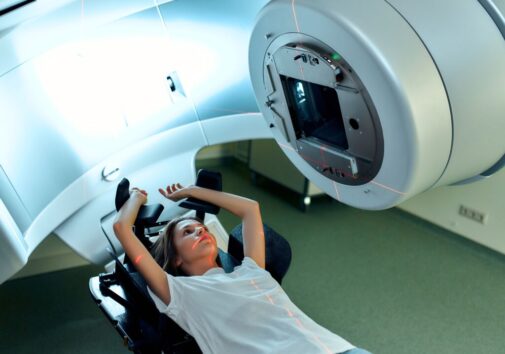Is this to thank for falling rates of cancer-related deaths?
Cancer mortality rates continue to fall in the U.S., according to American Cancer Society’s annual report. Early detection and declining rates of smoking both have played a large part, but improved cancer treatment options also deserve their due. New targeted cancer therapies and robotic surgeries receive most of the headlines, but what about radiation therapy?
“There have been huge advancements to radiation therapy in the past few decades,” says Dr. Jeffrey Kittel, a radiation oncologist at Aurora Health Care. “This is important because the statistics show that more than half of all people treated for cancer receive some form of radiation therapy, sometimes on its own, but typically in conjunction with other cancer treatments.”
How does radiation therapy work?
Radiation therapy uses invisible radioactive energy waves to damage the DNA of cancer cells, which can destroy the cells and stop them from dividing. But unlike chemotherapy, which is delivered through an IV and circulates throughout the entire body, radiation therapy is typically targeted directly at a tumor.
“Radiation therapy is great at controlling localized cancer, or cancer that has not spread to other parts of the body,” Dr. Kittel says.
Radiation therapy can be used for several different purposes:
- As a first-line treatment to shrink a tumor, potentially eliminating it completely
- Before surgery, to shrink the size of a tumor, which is called “neoadjuvant therapy”
- After surgery, to prevent cancer from returning, which is called “adjuvant therapy”
- In conjunction with anti-cancer drugs that make cancer cells more sensitive to radiation
- To alleviate symptoms for people whose cancer cannot be cured
- To treat cancer after it has returned
Types of radiation therapy
There are two main types of radiation therapy: Internal and external radiation therapy.
For internal radiation therapy, also called brachytherapy, doctors place a small radioactive source inside the body near the tumor.
External radiation therapy is more common and involves sending beams of radioactive energy through the skin, directly at a tumor inside the body. The radiation travels through the skin and other parts of the body, but it is typically delivered in such a way that most of the radiation collects near the tumor.
“With external radiation, doctors use imaging technologies to map out the body and the cancer with the goal of delivering the maximum dose of radiation without damaging healthy nearby tissue,” Dr. Kittel says.
Advancements in radiation therapy
Doctors continue to find new ways to improve radiation therapy, delivering it with increased precision, concentrating the doses into fewer treatments and even providing radiation during surgery.
Researchers at Advocate Health Care and Aurora Health Care are studying the use of a highly precise form of radiation called stereotactic body radiation therapy to treat people with lung cancer that cannot be removed with surgery.
“With stereotactic body radiation therapy, we can use many smaller beams of energy to deliver a much higher dose of radiation with extreme precision,” Dr. Kittel says. “And compared to conventional radiation, which is given in small doses each day for weeks at a time, stereotactic radiation therapy is typically delivered in as little as one to five treatments.”
Overall, cancer mortality rates are falling because cancer care no longer involves one-size-fits-all solutions, Dr. Kittel emphasizes, so be sure to discuss your options with your doctor.
Are you interested in learning your lung cancer risk? Take a free online quiz.
Learn more about clinical trials and research at Advocate Aurora Research Institute.



















You should also have mentioned Proton Radiation which is now being used in certain eye cancers as well as very deep cancers in other areas of the body with targeted precision so as not to harm other nearby tissues and organs!
Yes, I agree with the above commenter!!